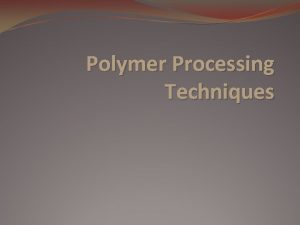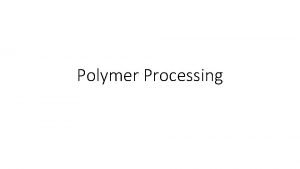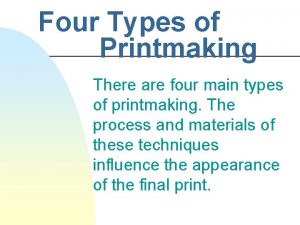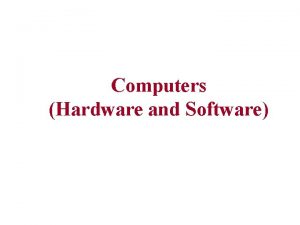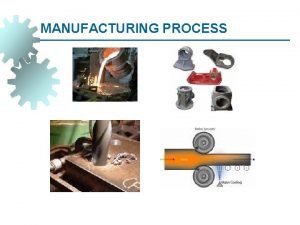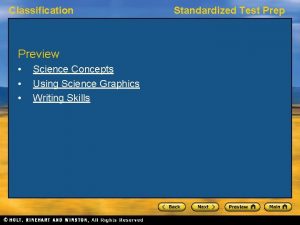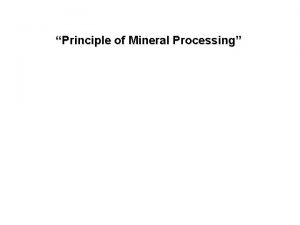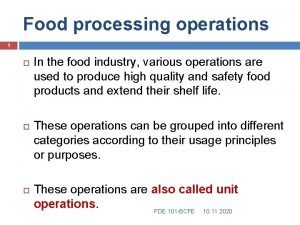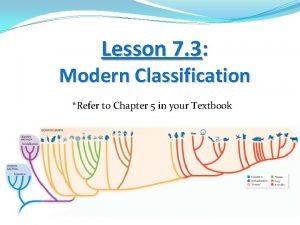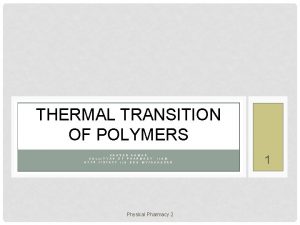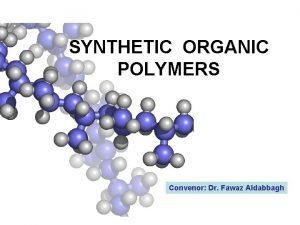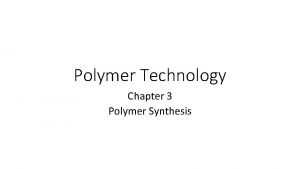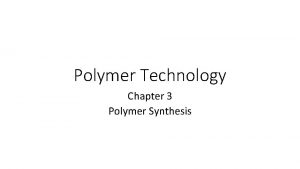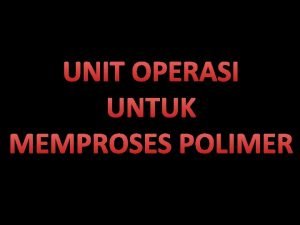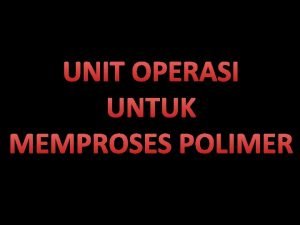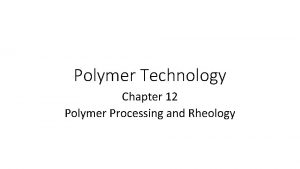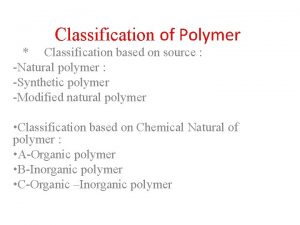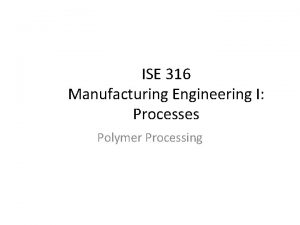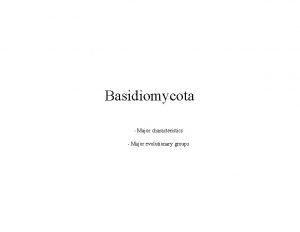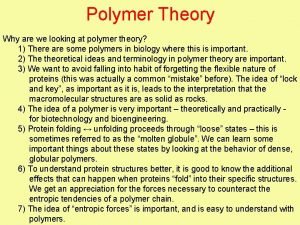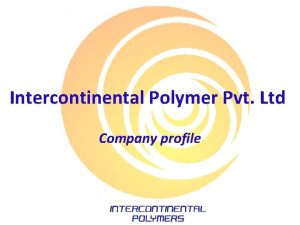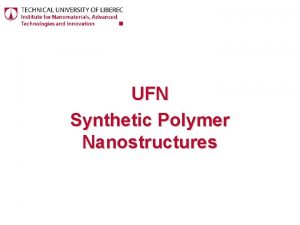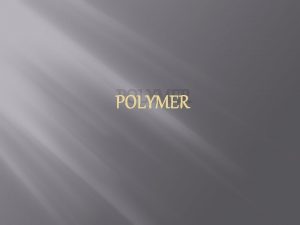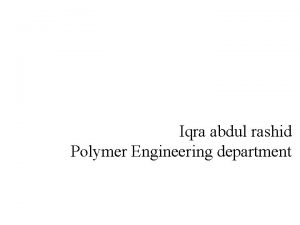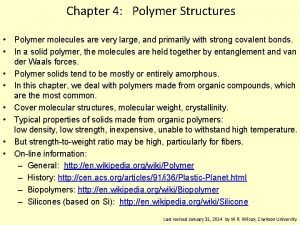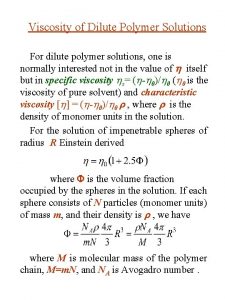Polymer Processing Classification of Polymer Processes Major Processes




























- Slides: 28

Polymer Processing

Classification of Polymer Processes Major Processes of Thermoplastics Extrusion Postdie Processing Forming Extruder main device used to melt and pump thermoplastics -fiber spinning -film blowing -sheet forming -blow molding -thermoforming -compression molding Single-Screw Extruder Twin-Screw Extruder Injection Molding -Polymer melted and pumped forward -Polymer melt is pushed into the mold

Processing Methods • The processing method is chosen according to the desired shape and quantity • Fiber, film, sheet, tube • Cup, bucket, car bumper, chair • Large quantities • Smaller quantities extrusion, injection molding compression molding, transfer molding

Extrusion • Extrusion is a compression process usually used for thermoplastics • Material is forced to flow through a die orifice • Cross-sectional shape determined by the shape of die orifice • Products • Tubes, pipes • Window and door moldings • Sheet and film • Coated electric wires and cables

Extruder Types • Screw Extruders • Single Screw Extruders • Multi-Screw Extruders: Twin screw, Gear Pump • Disk or Drum Extruders • Viscous Drag Type Extruders • Elastic Melt Extruders • Reciprocating Extruders • Ram extruders • Reciprocating Screw Extruder

Extruders • Extruder is a machine that, by the action o a screw, converts solid polymer to a melt and generates pressure to force it through a shaping die. • As the material passes through the die, the material acquires the shape of the die opening. • Materials can be extruded in the -molten state or acts purely as a pump -solid state performs an additional function of melting • There are two basic types of extruders: -continuous and -discontinuous or batch type Injection molding Blow molding

Extruder-Terminology Channel Leakage gap Direction of melt flow Head Polymer melt flows through moving channel of the turning screw and stationary barrel Feed zone: solid transport zone, preheating Melting/plastication zone: melting and degassing occurs Pump/metering zone: internal heating from viscous flow, pressure is developed to extrude the material through die

Extruder • Barrel: • Provides rigid surface • Jacketed with heating elements and thermocouples • Screw: • • • Conveys resin through extruder Gives mechanical energy to polymer melt Mixing ingredientstogether Builds pressure to push resin through die L/D is a measure of the capability of the screw to mix and melt the materials High L/D means good mixing and melting • Die: Gives shape to the melt Design of die needs to ensure proper melt flow

Extruders • Main device used to melt and pump thermoplastics • Material enters from the feed hopper. • As material falls down into the extruder barrel frictional forces will act on the material. • These frictional forces are responsible for the forward transport of the material. • As the material moves forward, it will heat up as a result of frictional heat generation and because of heat conducted from the barrel heaters. • When the temperature of the material exceeds the melting point, solids conveying zone ends and the plasticating zone starts. • When all solid polymer has disappeared, the end of the plasticating zone has been reached and the melt conveying zone starts. • In the melt-conveying zone, the polymer melt is simply pumped to the die. • As the polymer flows through the die, it adopts the shape of the flow channel of the die. • Since the die exerts a resistance to flow, a pressure is required to force the material through the die. • This is generally referred to as the diehead pressure.

Extruder-Terminology Channel depth: changes in the melting section, constant in pump zone The lengths of zones change depeding on the polymer being processed. For example: melting zone is short for materials melt easily and long for materials melt gradualy

Channel Depth • Pressure applied to the polymer melt is a function of channel depth Feed section: channel depth is relatively large which allows lots of granular polymer to barrel Compression section: channel depth gets smaller in which additional pressure is applied Melt section: channel depth is the smallest

Extruders • Single-Screw Extruders -basically consists of a screw that rotates within a metallic barrel -main function to melt solid polymer and to deliver a homogenous melt to die -Length to diameter ratio (L/D)usually falls in the range of 20 -24 (diameters are in the range of 1. 25 to 50 cm) -Primary design factors screw pitch (or helix angle) channel depth profile -can be used as a mixing device, a reactor, and a devolatilization tool.

Single-Screw Extruder

Extruder Screw Geometries -Feed section: to advance the resin -Compression section: to melt the resin -Metering section: to homogenize the resin and pump it forward

Extruders • Twin-Screw Extruders -many different configurations available: v corotating and counterrotating vintermeshing and nonintermeshing Used for compounding and mixing operations Analysis and design of these devices is complicated

Extruders Vented Extruders • A vented extruder is equipped with one or two openings in the extruder barrel, through which volatiles can escape • Openings can be used for adding certain components to the polymer such as additives, fillers, etc. • Main problem is vent flow.

Extruders Single Ram Extruders • Ram extruders are essentially positive displacement devices • Simple in design, discontinuous in operation • Used in some specil polymer processing operations such as extrusion of interactable polymers

Shaping device: Die -A die is a part located at the exit of the extruder with one or several openings where the material being processed comes through under pressure. -The performance of the extruder is affected by the resistance to flow offered by the die. Extruder design Die design -Problems in die design: ØDistributing the melt flow uniformly ØObtaining a uniform thermal history ØPredicting the dimensions to obtain the desired final shape ØProduction of smooth extrudate

Shaping device: Die • There are many types of extrusion die geometries for producing: • • • sheet and film pipe and tubing rods and fiber irregular cross sections coating wire Design Problems -Melt flowing under laminar flow -Highest extrusion rate possible -To obtain a coating of polymer of specified thickness and uniformity

Diehead pressure • The diehead pressure is determined by • the shape of the die (particularly the flow channel), • the temperature of the polymer melt, • the flow rate through the die, and • the rheological properties of the polymer melt. • It is important to understand that the diehead pressure is caused by the die, and not by the extruder!

Postdie Processing Operations • The shape and thickness or diameter of the extrudate are determined by the: • • Rheological properties of the melt Die dimensions Cooling conditions Take-up speed relative to the extrusion rate • The physical and optical properties are determined by the cooling rates and streching conditions of the melt during the cooling process.

Postdie Processing Operations

Forming- Blow Molding Blow molding: a parison, which has been extruded or injection molded, is inflated by air until it fills the mold cavity. The inflated parison is held in contact with the cold mold walls until it is solidified.

Forming-Thermoforming: a sheet polymer is heated by radiation to a temperature above its glass transition temperature and then pressed into the mold.

Forming- Compression Molding The polymer is put between stationary and movable members of a mold. The mold is closed and T and P are applied.

Injection Molding Reciprocating screw Advantages of reciprocoating screw machines: -better melting characteristics -easier to control -require less thermal heat because they also induce mechanical heating. -more uniform melt. • Design considerations • • • Required injection pressure Location of the weld lines Cooling rates Length of hold time in the mold Distribution of the molecular orientation Ram injector

Processing of Thermosetting Systems • Reaction injection molding • Compression molding • Pultrusion thermosetting composites can be processed

Reaction injection molding (RIM) RIM: is a process in which two liquid intermediates are metered seperately to a mixing head where they are combined by high pressure mixing and flow into a mold where they are polymerized
 Polymer processing techniques
Polymer processing techniques Classification of polymer
Classification of polymer Concurrent in os
Concurrent in os What are the 4 types of printmaking?
What are the 4 types of printmaking? A computer system consists of both hardware and software.
A computer system consists of both hardware and software. Top down vs bottom up processing
Top down vs bottom up processing Bottom up processing vs top down processing
Bottom up processing vs top down processing Top-down processing vs bottom-up processing
Top-down processing vs bottom-up processing High boost filtering matlab
High boost filtering matlab Primary and secondary processing
Primary and secondary processing Point processing in image processing
Point processing in image processing Histogram processing in digital image processing
Histogram processing in digital image processing Parallel processing vs concurrent processing
Parallel processing vs concurrent processing Nonlinear image processing
Nonlinear image processing What is point processing in digital image processing
What is point processing in digital image processing Digital image processing
Digital image processing Top-down processing
Top-down processing What is interactive processing
What is interactive processing In production process
In production process 8 major levels of classification
8 major levels of classification 8 major levels of classification
8 major levels of classification Organisms taxonomy
Organisms taxonomy Classification in mineral processing
Classification in mineral processing Food industry
Food industry Eager learner vs lazy learner
Eager learner vs lazy learner Manifold classification example
Manifold classification example Traditional classification vs modern classification
Traditional classification vs modern classification Polymer tg and tm
Polymer tg and tm Polymerization of monomers
Polymerization of monomers
